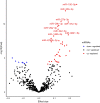Smoking-related dysregulation of plasma circulating microRNAs: the Rotterdam study
- PMID: 37430296
- PMCID: PMC10331979
- DOI: 10.1186/s40246-023-00504-5
Smoking-related dysregulation of plasma circulating microRNAs: the Rotterdam study
Abstract
Background: MicroRNAs (miRNAs) are post-transcriptional regulators of gene expression. Differential miRNA expression, which is widely shown to be associated with the pathogenesis of various diseases, can be influenced by lifestyle factors, including smoking. This study aimed to investigate the plasma miRNA signature of smoking habits, the potential effect of smoking cessation on miRNA levels, and relate the findings with lung cancer incidence.
Results: A targeted RNA-sequencing approach measured plasma miRNA levels in 2686 participants from the population-based Rotterdam study cohort. The association between cigarette smoking (current versus never) and 591 well-expressed miRNAs was assessed via adjusted linear regression models, identifying 41 smoking-associated miRNAs that passed the Bonferroni-corrected threshold (P < 0.05/591 = 8.46 × 10-5). Moreover, we found 42 miRNAs with a significant association (P < 8.46 × 10-5) between current (reference group) and former smokers. Then, we used adjusted linear regression models to explore the effect of smoking cessation time on miRNA expression levels. The expression levels of two miRNAs were significantly different within 5 years of cessation (P < 0.05/41 = 1.22 × 10-3) from current smokers, while for cessation time between 5 and 15 years we found 19 miRNAs to be significantly different from current smokers, and finally, 38 miRNAs were significantly different after more than 15 years of cessation time (P < 1.22 × 10-3). These results imply the reversibility of the smoking effect on plasma levels of at least 38 out of the 41 smoking-miRNAs following smoking cessation. Next, we found 8 out of the 41 smoking-related miRNAs to be nominally associated (P < 0.05) with the incidence of lung cancer.
Conclusions: This study demonstrates smoking-related dysregulation of plasma miRNAs, which might have a potential for reversibility when comparing different smoking cessation groups. The identified miRNAs are involved in several cancer-related pathways and include 8 miRNAs associated with lung cancer incidence. Our results may lay the groundwork for further investigation of miRNAs as potential mechanism linking smoking, gene expression and cancer.
Keywords: Circulating miRNAs; Lung cancer; Smoking; Smoking cessation.
© 2023. The Author(s).
Conflict of interest statement
The authors declare no conflict of interest.
Figures

Similar articles
-
Analysis of plasma microRNA expression profiles revealed different cancer susceptibility in healthy young adult smokers and middle-aged smokers.Oncotarget. 2016 Apr 19;7(16):21676-85. doi: 10.18632/oncotarget.7866. Oncotarget. 2016. PMID: 26943588 Free PMC article.
-
Plasma circulating microRNAs associated with obesity, body fat distribution, and fat mass: the Rotterdam Study.Int J Obes (Lond). 2022 Dec;46(12):2137-2144. doi: 10.1038/s41366-022-01227-8. Epub 2022 Oct 10. Int J Obes (Lond). 2022. PMID: 36216908
-
miRNA and Proteomic Dysregulation in Non-Small Cell Lung Cancer in Response to Cigarette Smoke.Microrna. 2018;7(1):38-53. doi: 10.2174/2211536607666180103165343. Microrna. 2018. PMID: 29299995
-
Smoking and microRNA dysregulation: a cancerous combination.Trends Mol Med. 2014 Jan;20(1):36-47. doi: 10.1016/j.molmed.2013.10.005. Epub 2013 Nov 13. Trends Mol Med. 2014. PMID: 24238736 Free PMC article. Review.
-
Identification of differentially expressed circulating serum microRNA for the diagnosis and prognosis of Indian non-small cell lung cancer patients.Curr Probl Cancer. 2020 Aug;44(4):100540. doi: 10.1016/j.currproblcancer.2020.100540. Epub 2020 Jan 23. Curr Probl Cancer. 2020. PMID: 32007320 Review.
Cited by
-
Lifestyle-Driven Variations in Nutrimiromic MicroRNA Expression Patterns across and beyond Genders.Life (Basel). 2024 Mar 15;14(3):390. doi: 10.3390/life14030390. Life (Basel). 2024. PMID: 38541714 Free PMC article.
-
Plasma Extracellular MicroRNAs Associated With Cardiovascular Disease Risk Factors in Middle-Aged and Older Adults.J Am Heart Assoc. 2024 Jun 18;13(12):e033674. doi: 10.1161/JAHA.123.033674. Epub 2024 Jun 11. J Am Heart Assoc. 2024. PMID: 38860398 Free PMC article.
-
Altered expression profile of plasma exosomal microRNAs in exclusive electronic cigarette adult users.Sci Rep. 2025 Jan 21;15(1):2714. doi: 10.1038/s41598-025-85373-9. Sci Rep. 2025. PMID: 39837838 Free PMC article.
-
miRNA Signatures in Alveolar Macrophages Related to Cigarette Smoke: Assessment and Bioinformatics Analysis.Int J Mol Sci. 2025 Feb 1;26(3):1277. doi: 10.3390/ijms26031277. Int J Mol Sci. 2025. PMID: 39941045 Free PMC article.
-
Persistent and novel changes in plasma microRNA profiles in patients with non-small cell lung cancer following tumour resection.Transl Lung Cancer Res. 2025 Mar 31;14(3):677-706. doi: 10.21037/tlcr-24-626. Epub 2025 Mar 27. Transl Lung Cancer Res. 2025. PMID: 40248723 Free PMC article.
References
-
- Prevention CfDCa. 2014 Surgeon general’s report: The health consequences of smoking—50 years of progress: centers for disease control and prevention; 2014 [Available from: https://www.cdc.gov/tobacco/data_statistics/sgr/50th-anniversary/index.htm. - PubMed
-
- Organization WH. Tobacco: WHO; 2021 [updated 26/07/2021. Available from: https://www.who.int/news-room/fact-sheets/detail/tobacco.
Publication types
MeSH terms
Substances
Associated data
LinkOut - more resources
Full Text Sources
Medical

